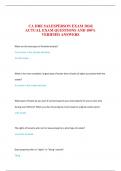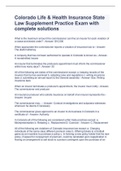Examen
ATI Learning System RN 3.0 Fundamentals 1 Quiz (questions and answers) verified 100%
- Cours
- Établissement
ATI Learning System RN 3.0 Fundamentals 1 Quiz (questions and answers) verified 100% A nurse is assessing the heart sounds of a client who has developed chest pain that becomes worse with inspiration. The nurse auscultates a high-pitched scratching sound during both systole and diastole with t...
[Montrer plus]












